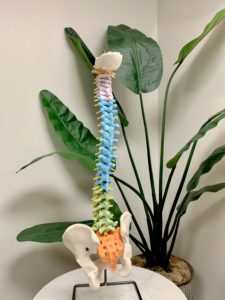
As chiropractors, we know how crucial good spinal health is for the whole body. But often, it’s overlooked in favor of other aspects of your health. Today, we take a look at the anatomy of the spine—its function, parts and pieces, and what makes it one of the most critical systems in the body.
The Spine—Your Lifeline
The spine is a column comprised of 24 movable bones (known as vertebrae) that protect the spinal cord and nerves, enabling the brain to send messages to other parts of the body. It provides the structural support and balance your whole body needs to keep upright, impacting overall mobility, flexibility and much more.
The spine itself is made up of three regions—the cervical, thoracic and lumbar spines—and each has its own role to play.
The Cervical Spine
Your cervical spine, made up of the first seven vertebrae at the top of the spine, is located in the neck. It supports the head, enables its flexibility and facilitates blood flow to the brain. It houses and protects the top section of the spinal cord, playing a crucial role in the function of your central nervous system.
The Thoracic Spine
The longest region of the spine, the thoracic spine, is made of twelve different vertebrae that span from just below the base of the neck (cervical) to the stomach region (lumbar). This section of the spine plays a critical role in overall function of the body, not only protecting a large portion of the spinal cord but also anchoring down the ribs so they can protect the heart and lungs.
The Lumbar Spine
Comprised of five vertebrae in the lower abdomen and hips, the lumbar spine is built for power and stability. It holds the weight of your entire torso, and gives the hips and legs the ability to flex. This region of the spine is a strong coat of armor, protecting the base of your spinal cord so it can do its job without interference. Much like the other regions of the spine, the lumbar spine protects the delicate spinal cord and nerves, playing an important role in the nervous system.



Leave A Comment
You must be logged in to post a comment.